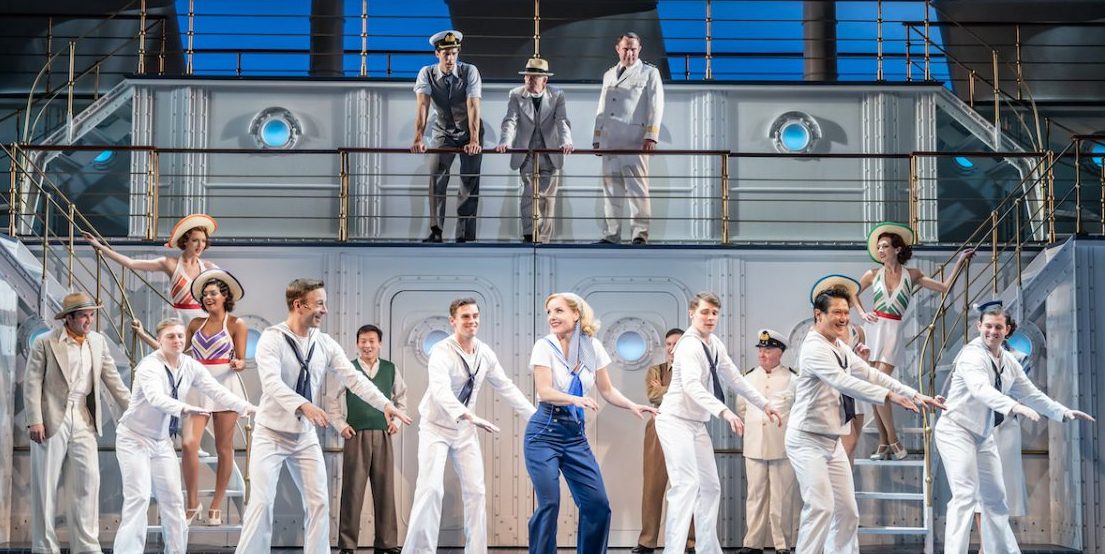After huge success in its first iteration this production of Cole Porter’s Depression-era pick-me-up musical returns to the Barbican with a new cast. This reviewer never saw the earlier production and so has no basis of comparison; but on the strength of the press night it is still a truly frothy, escapist tonic for our troubled times.
From the first notes of the overture, you know you are in for an evening of top-quality musical values. It’s a broad, brassy, rhythmically incisive sound under the dynamic leadership of Mark Aspinall, ready to riff off a score that is one of Porter’s peerless best, with nary a weak number in either act. The plot is as insubstantial as sea mist or candyfloss, focused essentially on two couples misaligned at the start and put back in order by the end, with a welter of comic supporting sub-plots, all set aboard the closed community of a trans-Atlantic ocean liner.
Just as the show is bang up to date with latest jazz inflections so it also looks backwards to the traditions of vaudeville, and G&S operetta, turning as it does on a classic piece of Gilbertian topsy-turvy in which the leading man, mistaken for being a gangster and ‘public-enemy-number-one’ is immediately feted as a hero because any successful ocean liner simply must have celebrities. But the satire is gentle, and the audience willingly succumbs to wave upon wave of intoxicating slapstick nonsense, especially when presented with the wit, charm and innuendo of numbers such as ‘You’re the top’ and ‘De-Lovely’ and the show-stopping tap-dance and chorus routines of the title number and ‘Blow, Gabriel, Blow.’
Before we turn to the cast, we must celebrate the flexible multi-level set created by Derek McLane, which presents a cross-section of the decks, several sinuous gangways, lots of doorways and portholes for farcical business, and a broad sky behind a parade of funnels for moody lighting effects night and day. It is a wonderful backdrop in itself, and plenty large enough to accommodate a ballroom and cabins when the scene changes.
Leading the cast is the multi-talented and truly indefatigable Kerry Ellis, as showgirl, Reno Sweeney, a role originally taken by Ethel Merman. She hardly seems to get out of breath alternating some mean tap routines and songs that cover a wide range from cheeky patter absolute belt. Alongside her, Nicole Lily-Baisden more than holds her own in the ingenue role of Hope Harcourt, and they are complimented by two very talented leading men, Samuel Edwards and Haydn Oakley as Billy Crocker and Lord Evelyn Oakleigh. Particularly striking was Oakley’s transformation of his character from fatuous English aristocrat (you can tell P.G.Wodehouse was involved in writing the book!) into the red-blooded toreador of ‘The Gypsy in Me.’
Many of the comic gags revolve around the stock minor characters where it is traditional to bring in some famous names to strut their stuff. So we had Simon Callow having a whale of a time as a clueless elderly banker left helpless without his spectacles; Bonnie Langford inhabiting the role of an easy to deceive mother(-in-law) over-attached to a lapdog; and Denis Lawson as a stowaway villain and gambler disguised as a celebrity evangelist. Accents were not perfect, but comic timing was. Another stand-out brassy performance came from Carly Mercedes Dyer as Erma, the gangster’s moll ready to seduce a host of sailors.
There are not as many show-stopping set-pieces as you might think from the show’s reputation, but they are done to perfection here thanks to the choreography of Kathleen Marshall, who also directs. These are very carefully constructed with points of repose in between the various climaxes and alternating sequences of song, dance and tap for different sized groups. The chorus and dancers are of course the sailors and passengers of the ocean liner itself, so they quite naturally flow in and out of action as needed. You felt as one variation and elaboration of each number topped the other that the performers and orchestra would quite happily have gone on all night. Indeed, as we left the theatre the orchestra was still taking the themes into fresh, exciting combinations.
There are some minor flaws. The book, which was ultimately the work of many hands, both in the original and in a modern updated version, is sometimes quite laboured. Some jokes go on too long or were never that funny to start with, especially in the long expository first half. But ultimately the sublimely carefree music and carefully calibrated production values sweep reservations away.

